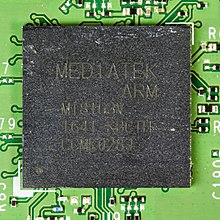This article needs additional citations for verification. (November 2015) |
 A picture of the Amazon Echo Dot (RS03QR) - motherboard | |
| General information | |
|---|---|
| Launched | 2012 |
| Designed by | ARM Holdings |
| Performance | |
| Max. CPU clock rate | 400 MHz to 2.30 GHz |
| FSB speeds | 100 MHz to 118 MHz OC |
| Cache | |
| L1 cache | 8–64 KiB |
| L2 cache | 128 KiB – 2 MiB |
| Architecture and classification | |
| Instruction set | ARMv8-A |
| Physical specifications | |
| Cores |
|
| Products, models, variants | |
| Product code name |
|
| History | |
| Predecessor | ARM Cortex-A7 |
| Successor | ARM Cortex-A55 |
The ARM Cortex-A53 is one of the first two central processing units implementing the ARMv8-A 64-bit instruction set designed by ARM Holdings' Cambridge design centre, along with the Cortex-A57. The Cortex-A53 is a 2-wide decode superscalar processor, capable of dual-issuing some instructions.[1] It was announced October 30, 2012[2] and is marketed by ARM as either a stand-alone, more energy-efficient alternative to the more powerful Cortex-A57 microarchitecture, or to be used alongside a more powerful microarchitecture in a big.LITTLE configuration. It is available as an IP core to licensees, like other ARM intellectual property and processor designs.
Overview
[edit]- 8-stage pipelined processor with 2-way superscalar, in-order execution pipeline
- DSP and NEON SIMD extensions are mandatory per core
- VFPv4 Floating Point Unit onboard (per core)
- Hardware virtualization support
- TrustZone security extensions
- 64-byte cache lines
- 10-entry L1 TLB, and 512-entry L2 TLB
- 4 KiB conditional branch predictor, 256-entry indirect branch predictor
Utilization
[edit]The Cortex-A53 is the most widely used platform for mobile SoCs since 2014 to the present day [as of?], making it one of the longest-running ARM platform for mobile devices. It is currently featured in most entry-level and lower mid-range SoCs, while higher-end SoCs used the newer ARM Cortex-A55. The latest SoC still using the Cortex-A53 is the MediaTek Helio G50, which is an entry-level SoC designed for budget smartphones.
The ARM Cortex-A53 processor has been used in the LeMaker HiKey since 2015,[3] the Raspberry Pi 3 since February 2016,[4] and the Raspberry Pi Zero 2 W since October 2021.[5]
The Cortex-A53 is also used in a number of Qualcomm, Samsung, and MediaTek SoCs.[6][7][8] Semi-custom derivatives of the Cortex-A53 have been used in Qualcomm's Kryo 250 and Kryo 260 CPUs.[9][10] The Starlink ground terminals utilize a quad-core Cortex-A53 SoC from STMicroelectronics as a main control unit.[11]
The processor is used in the ODROID-C2[12] and in Roku streaming media players (in the high-end models from 2016 and in all models released between 2017 and 2019). Another notable Cortex-A53 application is the Pine A64/A64+ single-board computer.
These cores are used in a 24-core SoC, the Socionext SynQuacer SC2A11.
The processor is used in Amazon Fire tablets, including the Fire HD 8 and the Fire HD 10 (the latter also includes Cortex-A72 cores). It is also used in some Amazon Echo Show models such as the Echo Show 5, Echo Show 8, and Echo Show 5 (2nd Gen).[13]
The processor is used in Fortinet's Fortigate 81F entry-level firewalls.
See also
[edit]References
[edit]- ^ "Cortex-A53 Processor". ARM Holdings. Retrieved 2015-11-08.
- ^ "ARM Launches Cortex-A50 Series, the World's Most Energy-Efficient 64-bit Processors" (Press release). ARM Holdings. 2012-10-30. Retrieved 2023-05-15.
- ^ "HiKey attends the ET Show in Japan 2015". LeMaker. 12 November 2015. Archived from the original on 2018-07-18. Retrieved 2018-07-17.
- ^ Upton, Eben (29 February 2016). "Raspberry Pi 3 on sale now at $35 - Raspberry Pi". Raspberry Pi. Retrieved 2016-02-29.
- ^ "Raspberry Pi Zero 2 W Product Brief" (PDF). Raspberry Pi. 28 October 2021. Retrieved 2021-10-28.
- ^ Lal Shimpi, Anand (9 December 2013). "Qualcomm Announces Snapdragon 410 based on 64-bit ARM Cortex A53". Anandtech. Retrieved 9 March 2017.
- ^ Lal Shimpi, Anand (24 February 2014). "Snapdragon 610 & 615: Qualcomm Continues down its 64-bit warpath with 4/8-core Cortex A53 designs". Anandtech. Retrieved 9 March 2017.
- ^ "Snapdragon 625 Mobile Platform". Qualcomm.
- ^ "Snapdragon 632 Mobile Platform". Qualcomm.
- ^ "Snapdragon 660 Mobile Platform". Qualcomm.
- ^ Wouters, Lennert (2022-08-10). Glitched on Earth by Humans: A Black-Box Security Evaluation of the SpaceX Starlink User Terminal (PDF). Black Hat USA 2022.
- ^ "en:c2_hardware [Odroid Wiki]". odroid.com. Retrieved 2017-03-26.
- ^ "All New Echo Show 5 – Compact smart display with Alexa". Amazon.